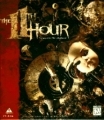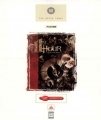The 11th Hour: The sequel to The 7th Guest
First posted on 26 April 1996. Last updated on 05 December 2013.

|
| Superior animations are the norm in this game! |

|
| The acting in this game is subdue. |

|
| Stauf plots another evil plan of murder and deceit. |
With over 4 years in development, The 11th Hour: The sequel to The 7th Guest is Trilobyte's attempt to capitalize on the success of The 7th Guest which considered by many to be the "killer app" that popularizes the CD-ROM technology. This time, the terror of Stauf falls on an investigator reporter whose girlfriend has mysteriously been kidnapped while investigating the Stauf mansion. Armed with a hefty production budget, can Trilobyte remake history by hailing Stauf's return? Unfortunately, not quite...
It has been years since that fatal night of murders inside the hilltop mansion owned by the enigmatic but reclusive toy maker Henry Stauf. It is now 1995. Your alter ego, Carl Denning Jr, is an investigative reporter of the hit television series Case Unsolved. As the producer of your show and your lover, Robin Morales has traveled to the little town of Harley to research on a series of grisly murders and disappearances that seem to be linked to the deserted Stauf mansion. When you learn that Robin has mysteriously disappeared, you travel to Harley immediately. Armed with a portable computer that has been delivered to you with a peculiar invitation, you set foot into the haunted mansion. Only after Carl has solved the many wicked puzzles left by Stauf before the 11th hour (with the help of the mysterious Samantha) will he gain insight into the true ordeal of the evil plans of Stauf. At the end, you must guide Carl to make one final moral decision in choosing between saving the lusty Marie, your lover Robin, or the helpful Samantha.
The 11th Hour: The sequel to The 7th Guest is by itself quite a piece of programming marvel. The Groovie authoring system or engine allows playback of full screen high resolution Full Motion Video clips at 30 frames per second. An option is even available in the GameBook to allow sequential playback of all the movie clips in their entirety for dramatic recaps. If played in their entirety, these clips actually constitute a 64 minutes full feature movie. Filming of the movie is done with both real sets and blue screen chromakey. Streaming stereo audio include original songs and lyrics from The Fatman who also orchestrated the music for The 7th Guest. All the graphics and animations are in high resolution SVGA. Choices are available to set the color depth to 8-bits, 16-bits, or 24-bits per pixel. There is even a "Spooky Mode" which converts the screen to a grayscale look for dramatic effect. This mode and the low color depth option allow slower computers to play the pre-rendered animations with reasonable speed. Various setup options are available to adjust the qualities of videos, animations, graphics and sounds to optimize hardware support.
Unlike its predecessor The 7th Guest, this game is structured more like a treasure hunt that is played out over 5 hours from 7 pm to midnight. At the end of each hour, the player is pitted against Stauf himself in a strategy game with an artificial intelligence. Between each hour, the player roams around the mansion to solve puzzles or find objects about which Stauf gives his riddles. The riddles are anagrams, and solving these riddles permit the player to hunt down a key object that will trigger off a video that propels forward the story. The portable computer Carl carries manifests as the GameBook through which the player manages the gameplay in the game. Stepwise clues are available in the GameBook through a so-called Techno-Psychic Ally who will give hints on unscrambling the anagrams (the final clue often gives out the answer).
Although the game warns against the player to use the Techno-Psychic Ally only sparingly because it may weaken the player's link with her and limit her ability to come to the player's assistance later, in reality this does not happen. The Techno-Psychic Ally will not give any help for the last puzzle anyway, regardless of what has happened before. The same applies to the warning by the game that excessive random clicking on objects may be detrimental to the gameplay later on.
Trilobyte has obviously excelled in all aspects of the production that has made The 7th Guest an apparent success. The high quality animations playing at almost full screen are simply stunning to see. With optimal hardware support, the videos play very smoothly. The "flashlight" effect is well done and contributes significantly to the eerie atmosphere. The various icons, such as the skeleton hand, the throbbing brain, and the rolling or pulsing eyeball, are nice touches. All the puzzles in the game are fully animated. Indeed, it can be said that no other game released up to now can spurt this degree of graphic prowess! Likewise, the moody sound effects are outstanding. The eight original songs written specifically for this game are humorous. For example, the song "Mr. Death" has the lyrics "I can't take a bath, with Mr. Death scrubbing my back...". An equally interesting addition is the bonus video clips on the "Making of The 11th Hour" that truly show the grand scale of this production. The use of real sets allows sophisticated manipulation of camera angles. The authentic looking leather-bound volume holding the game discs is by itself a collector's item!
Perhaps the greatest downfall of The 11th Hour: The sequel to The 7th Guest lies on its monotonic puzzles. The anagrams are silly and just about impossible to solve (perhaps because my English is terrible). One often has to resort to the GameBook for help. The other puzzles are mere rehashes of past classics. Some of the logic puzzles can be very difficult, such the dollhouse furniture puzzle. The puzzles using artificial intelligence are better done, but they often rely more on brute force than strategy. This means that if the artificial intelligence looks ahead far enough, the game becomes almost impossible to win simply because the human player will not have patience to analyze all the possible moves, not because the player is more stupid. Unfortunately, the repetitive putdowns by Stauf, played by Robert Hirschboeck, often frustrate rather than encourage the player.
The story is another weak link in this game. The typical B movie script gives rise to the acting that is mediocre at best. According to the developer, poor weather in Southern Oregon has plagued the filming of the video sequences, and shooting of the film has been hasty done in only 10 days. At the end, the choice that the player must make to save which girl is simply moronic! Obviously the writers have carefully chosen the character name Morales for good reasons. Anyone in their right mind will know which one to pick (although it is still fun to see the clips if the player chooses the other two). The ending is therefore uninspiring, vague, and anticlimactic.
The 11th Hour: The sequel to The 7th Guest is an example that a game with flashy graphics but poor gameplay does not do well. It is high in chrome, but low in substance. Rumor has circulated that the poor retail performance of this game is a key reason for the much publicized internal breakup of Trilobyte in 1996. Trilobyte has officially denied such allegation. It is even rumored that originally Trilobyte has no intention to make this sequel. Though superior in production value, uninspiring gameplay and frustrating anagrams fail to allow Stauf to remake gaming history.

